The 2024 Blazer EV is the latest addition to the GM electric vehicle lineup that is athletic and aggressive in both styling and performance. But it also features some exciting new technology.
The Blazer EV* will be offered in three distinct trims: LT, RS and SS. The LT has a monochromatic appearance with standard 19-inch wheels. The RS is sportier, with a Black grille and Gloss Black accents, as well as 21-inch wheels. (Fig. 1) The SS is the most aggressive trim, with a unique front grille, standard 22-inch wheels and a two-tone color scheme with a Black roof and A-pillars. Both the RS and SS have a dual-element LED exterior lighting signature with choregraphed lighting sequences that activate when the driver approached or walks away.
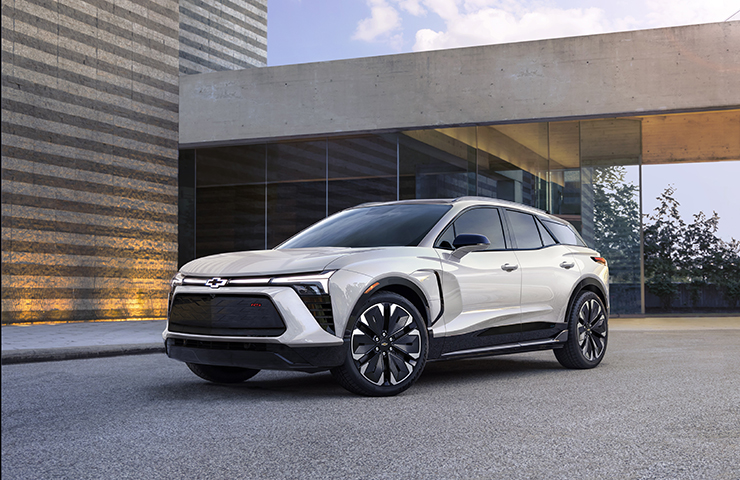 Fig. 1
Fig. 1
New Tech
The Blazer EV offers a number of available new tech features, such as Hands-Free Start, AutoSense Liftgate, a 17.7-inch diagonal customizable infotainment display (Fig. 2) and a powered charge port door.
 Fig. 2
Fig. 2
With Hands-Free Start, there’s no button to push to start the vehicle. The driver simply presses the brake pedal after closing the door, shifts into Drive or Reverse and the Blazer EV is ready to go. The key fob authorizes the hands-free start system and a Vehicle Ready indicator will illuminate on the instrument cluster when the vehicle is ready to drive. The system uses low-frequency antennas in three different locations on the vehicle to determine the location of the key fob (keyless entry transmitter).
Opening the available AutoSense Power Liftgate on the Blazer EV is easy. There is no need to kick to access the cargo area. The available presence-based power liftgate opens hands-free when the driver walks within 3 feet of the rear of the vehicle and stands for about 3 seconds with the key fob. The driver will hear a series of 4 beeps before the liftgate opens. The system must be enabled in the Vehicle Settings on the infotainment screen.
TIP: The AutoSense Power Liftgate can be turned on or off using the exterior liftgate switch. Press and hold the exterior switch on the liftgate for more than 5 seconds while holding the key fob to turn the AutoSense feature on or off. The taillights will flash.
The automated charge port door opens with a simple button press, displaying a light halo around the charge ports. (Fig. 3) Forget to close the charge port door after charging? That’s OK because, in that instance, the port door will automatically close once the vehicle is shifted into gear.
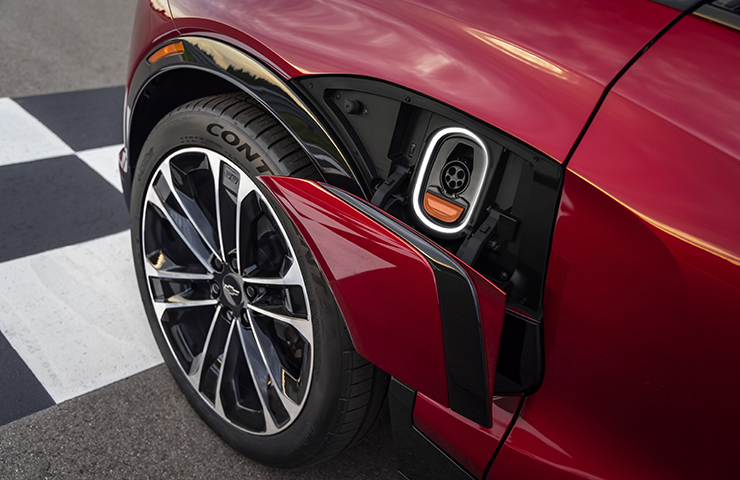 Fig. 3
Fig. 3
There are other features enabled by battery-powered electrification that make the Blazer EV comfortable and convenient. Regen On Demand is a driver-controlled feature that converts the kinetic energy of the Blazer EV’s forward momentum into electricity and transfers it back to the battery for future use. It’s activated by simply pulling a paddle behind the left side of the steering wheel. (Fig. 4) This feature can be used in tandem with One-Pedal Driving for maximum energy recovery.
Note: Features may be limited when battery temperatures are extremely cold or hot or when battery is near full charge. Always use the brake pedal when needing to stop immediately.
 Fig. 4
Fig. 4
The Blazer EV also comes with many of Chevrolet’s latest driver assistance technologies, including Reverse Automatic Braking and available Automatic Parking Assist. That’s in addition to standard safety technology such as Automatic Emergency Braking, Forward Collison Alert, Front Pedestrian Braking and Lane Keep Assist with Lane Departure Warning.
Note: Safety or driver assistance features are not a substitute for the driver’s responsibility to operate the vehicle in a safe manner. The driver should remain attentive to traffic, surroundings and road conditions at all times. Visibility, weather, and road conditions may affect feature performance. Read the vehicle Owner’s Manual for more important feature limitations and information.
Much of the Blazer EV’s technology is underpinned by General Motors’ Ultifi vehicle software platform. Ultifi separates the vehicle’s software from its hardware to enable frequent and seamless delivery of software-defined features, apps and services to customers remotely over the air.
Interior and Exterior Design
Inside, the Blazer EV boasts an all-new driver-focused experience with a vivid, 11-inch diagonal Driver Information Center and a massive 17.7-inch diagonal center touchscreen, both of which are completely customizable.
Each trim will have its own personality that customers can suit to their tastes, picking from vibrant color themes, illuminated decor and other unique embellishments. A dual-pane power panoramic sunroof is an available option that gives the Blazer EV an open-air feel. (Fig. 5)
 Fig. 5
Fig. 5
To control the Blazer EV, Electronic Precision Shift lets the driver shift gears electronically using a steering column-mounted electronic joystick-style lever, rather than using a traditional mechanical connection. (Fig. 6)
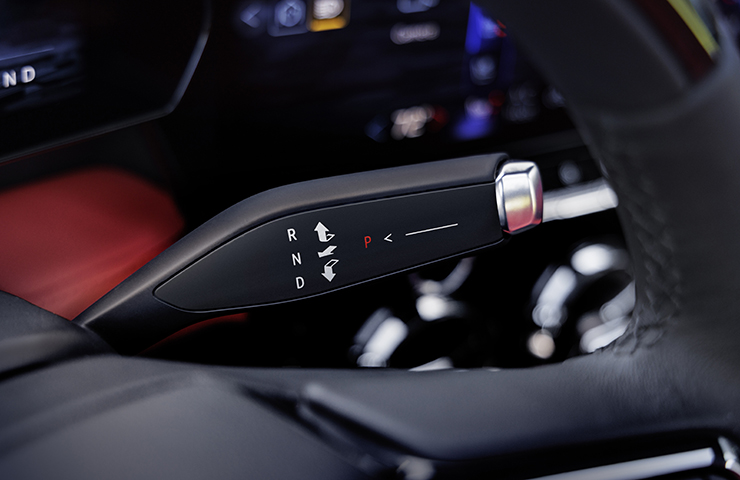 Fig. 6
Fig. 6
Power and Performance
The all-new body architecture supports multiple range options and three available drive systems: eAWD, rear-wheel drive and Performance AWD.
Powered by GM’s Ultium Platform, on a full charge the Blazer EV gets an EPA-estimated range of 279 miles for the 2LT trim, a GM-estimated range of 320 miles on the RS trim and a GM-estimated range of 290 miles on the SS trim. The eAWD is standard on the 2LT and RS trims, and rear-wheel drive is available on RS. Performance AWD comes standard on the SS trim.
The Blazer EV SS has a GM-estimated 0-60 miles per hour tome of less than 4 seconds, enabled by Wide Open Watts performance mode, which produces up to 557 horsepower and 648 lb.-ft. of torque. (Fig. 7)
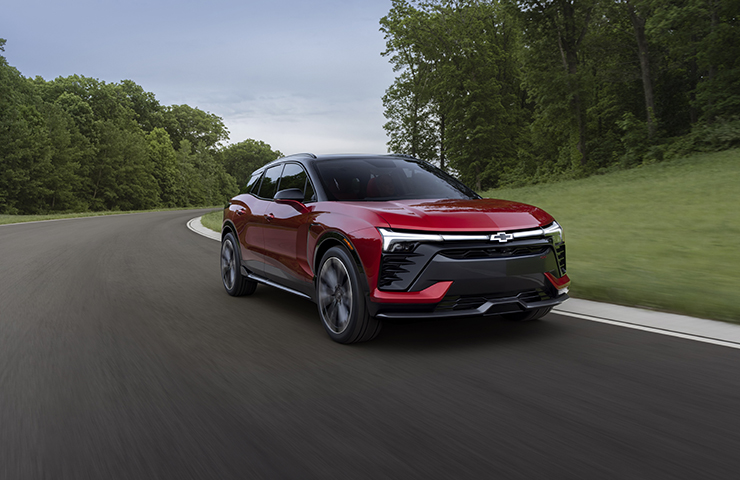 Fig. 7
Fig. 7
Innovative Engineering
The Blazer EV’s battery and body were designed at the same time to allow space to accommodate a long-range battery while also creating a structure that can protect its occupants and offer a great ride and handling. The Ultium battery modules are horizontally configured along the vehicle underbody, and the battery pack allows for a nearly 50/50 weight distribution of the vehicle and a lower center of gravity, which provides a stable foundation for great ride and handling.
The battery system also features Ultium energy recovery, an innovative heat cycling system that uses thermal energy from the vehicle’s battery to heat the vehicle interior, thus increasing overall efficiency.
The Battery Electric Vehicle Active Thermal Management system combines two normally independent systems to form one integrated thermal system, resulting in enhanced overall thermal efficiency. The refrigerant system is utilized to heat as well as cool the vehicle cabin using a condensing heater and evaporator. This differs from more traditional refrigerant systems that are only used to cool the vehicle cabin.
The system utilizes a coolant loop with a series of pumps and multi-position valves to remove generated heat from the propulsion components. The thermal energy in the coolant loop interacts with the refrigerant loop through a heat exchanger, and can be utilized to provide cabin heat. It also is activated during charging events in order to keep the high-voltage battery at an optimal temperature. Thermal energy removed during charging events can be stored and used to provide cabin heat during the next drive cycle if needed.
Charging
When charging at home, the Blazer EV can use a Level 2 AC charger up to 11.5 kW, which adds up to 29 miles of range per charging hour. With a Dual Level Charge Cord, owners can use a standard 3-prong power outlet for 120-volt, Level 1 charging, or a 4-prong power outlet for faster, 240-volt Level 2 charging.
Owners can also use a standard high-speed DC fast-charging capability up to 190 kW that adds up to a GM-estimated 74 miles of range in just 10 minutes of charging at a public station. (Fig. 8)
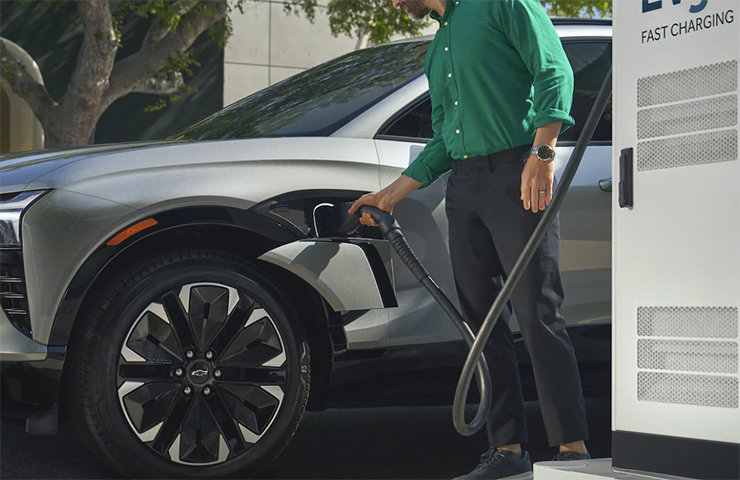 Fig. 8
Fig. 8
Essential Tools
Several new special service tools have been released to service the Blazer EV. The new tools include:
DT-53381 Seal Protector
DT-53369 Seal Installer
EL-53076-10A Battery Pack Cooling System Leak Test Caps
J-46625-10 Holding Fixture Adapter
GE-46143-A Adapters, Battery Cooling System Pressure Test
DT-53084-10 Stator Hairpin Cover
DT-50712 Bearing Cup Remover
DT-51919 Bearing Cup Puller
In addition to the new tools, other required special service tools for the Blazer EV are carry-over tools that have been previously supplied to all Chevrolet dealerships. Go gmtoolsandequipment.com for more information about GM Special Service Tools.
For additional details about the all-new 2024 Blazer EV, refer to Bulletin 23-NA-136.
*Preproduction model shown throughout. Actual production model may vary.
– Thanks to Bill Taylor


















